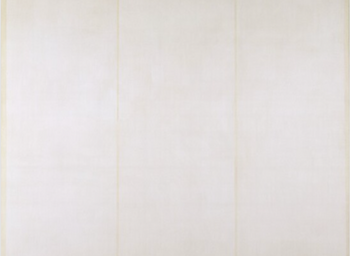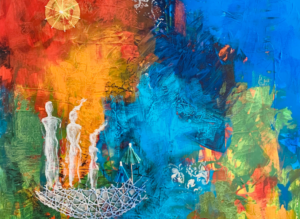In the Abstract

Above: Barnett Newman‘s 1950 “The Name II” magna and oil painting (104 x 94.5″)
American Paintings: An Illustrated Catalogue. National Gallery of Art, Washington, 1992: 242, repro.
After the Holocaust, the question of God’s presence or absence became an important theological question. How could a God traditionally understood as all-powerful, all-good, and engaged with humans, have allowed such an event to transpire? For some, the Holocaust proved God’s absence. For others, the conviction of God’s presence saved them. Astonishingly, Clement Greenberg, Harold Rosenberg, and subsequent critics insisted that the Abstract Expressionists were concerned, however, only with form and never with content: unique within art history, disinterested in the world.
Far from being disinterested, Barnett Newman presented God’s presence/absence as the central idea within his 1950 “The Name II”—an all-white painting marked by two thin, vertical gold strips that present it as a stylized triptych. Newman has offered a version of an essential Christian form within Western painting—its centuries-old configuration symbolizing the triune God: threefold and one. Christ-as-God traditionally occupies the central panel: on his Mother’s lap, flanked by saints; or on the Cross, flanked by the two thieves.
But Newman has offered a Jewish re-vision of that figurative representation, an imageless image of the figureless God. Newman’s title announces exactly what he is doing. Those conversant with the Jewish tradition know that the very name of God is not uttered beyond the context of prayer; instead one substitutes the double circumlocution, HaShem, meaning The Name—for even the Name, Adonai, uttered in prayer, is a circumlocution for the ineffable, real Name of God. The artist depicts God via visual circumlocution: his imageless image is a color that is an apparent lack of color. He asserts his place within Western, Christian art, entering the thematic soul of that art on Jewish terms. And he has addressed the painful absence/presence post-Holocaust question. For Newman and his viewer know that white is not only the absence of color, but—both chemically and in its traditional role as a symbol of light—the totality of color.
Thus, color is both absent and present, just as God may be seen as both absent and present. Moreover, because white can symbolize light, “The Name II” offers an act of visual tikkun olam. The unified image carefully orders—restores order to—post-Holocaust reality on the microcosm of the canvas, utilizing God’s first ordering instrument: light. The creator-artist emulates God’s macrocosmic process in Genesis. His creative act resonates from the Lurianic kabbalistic focus on tikkun that Newman and his fellow Jewish chromaticists were intensely discussing in their New York studios into the 1950s.
Ori Z. Soltes teaches at Georgetown University across a diverse range of disciplines.
Reflections
Step 1
Consider the discussion of "Jewish art" by Clement Greenberg and Harold Rosenberg.
Step 2
Juxtapose this first issue with the discussion of Abstract Expressionism.
For those who want to do further reading:
Step 3
Read and consider Barbara Rose's discussion of this same subject in her classic work, American Art Since 1900.
Step 4
Juxtapose all of the above with Fixing the World: Jewish American Painters in the Twentieth Century and his Tradition and Transformation: Three Millennia of Jewish art and Architecture.
Want more?
Get curated JewishArts.org content in your inbox



